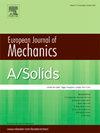Quasi-static behavior and energy absorption of bidirectional re-entrant cross-star honeycomb with multi-step deformation
IF 4.2
2区 工程技术
Q1 MECHANICS
引用次数: 0
Abstract
Auxetic honeycombs with multi-step deformation are critical for energy absorption applications, yet conventional designs often suffer from single-stage stress plateaus and unstable collapse modes. To address these limitations, this study proposes a novel bidirectional re-entrant cross-star honeycomb (BRSH) through a deformation coordination strategy that integrates reinforcement ribs and internal cross-star embedding. The BRSH replaces concave corners of traditional star-shaped units with linear ribs, introduces transverse inclined ribs, and embeds a cross-star substructure to enable synergistic multi-step deformation. Quasi-static compression tests and finite element (FE) simulations demonstrate that the BRSH exhibits three distinct stress plateaus without initial peak stress, achieving a more than 90 % enhancement in specific energy absorption (SEA) compared to other conventional auxetic honeycombs. Theoretical models based on plastic hinge energy dissipation accurately predict the plateau stresses, revealing a 362.6 % increase in the third plateau stress over the first stage. Furthermore, parametric studies highlight the tunability of the BRSH: adjusting geometric parameters (e.g., β, γ, l4) allows switching between one-, two-, or three-step deformation modes, while the Poisson's ratio can be tailored from −0.09 to −0.80. The novelty of this work lies in the innovative structural design of the metamaterial and its resulting distinctive mechanical response. And these results establish the BRSH as a high-performance energy absorber with design flexibility, offering new avenues for lightweight and multi-level protective structures in aerospace and automotive engineering.
具有多步变形的双向再入十字星蜂窝准静态行为及能量吸收
具有多步变形的辅助蜂窝对于能量吸收应用至关重要,然而传统的设计经常遭受单级应力平台和不稳定的崩溃模式。为了解决这些局限性,本研究提出了一种新型的双向再入交叉星蜂窝(BRSH),通过变形协调策略集成了加固肋和内部交叉星嵌入。BRSH用线性肋取代了传统星形单元的凹角,引入了横向倾斜肋,并嵌入了交叉星形子结构,以实现协同多步变形。准静态压缩试验和有限元(FE)模拟表明,BRSH在没有初始峰值应力的情况下表现出三个不同的应力高原,与其他传统的消声蜂窝相比,其比能吸收(SEA)提高了90%以上。基于塑性铰能量耗散的理论模型准确地预测了高原应力,表明第三阶段的高原应力比第一阶段增加了362.6%。此外,参数研究强调了BRSH的可调性:调整几何参数(例如,β, γ, 14)允许在一步,两步或三步变形模式之间切换,而泊松比可以从- 0.09到- 0.80进行定制。这项工作的新颖之处在于超材料的创新结构设计及其产生的独特的机械响应。这些结果确立了BRSH作为一种具有设计灵活性的高性能能量吸收材料,为航空航天和汽车工程中的轻量化和多级保护结构提供了新的途径。
本文章由计算机程序翻译,如有差异,请以英文原文为准。
求助全文
约1分钟内获得全文
求助全文
来源期刊
CiteScore
7.00
自引率
7.30%
发文量
275
审稿时长
48 days
期刊介绍:
The European Journal of Mechanics endash; A/Solids continues to publish articles in English in all areas of Solid Mechanics from the physical and mathematical basis to materials engineering, technological applications and methods of modern computational mechanics, both pure and applied research.

 求助内容:
求助内容: 应助结果提醒方式:
应助结果提醒方式:


